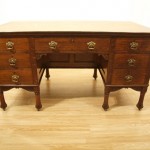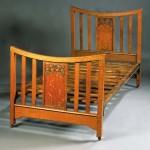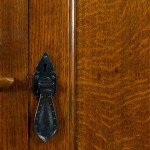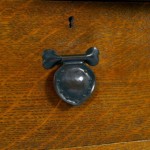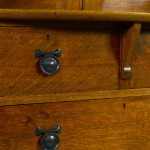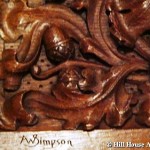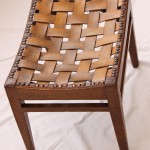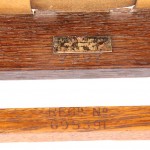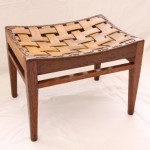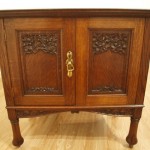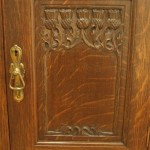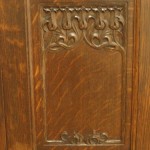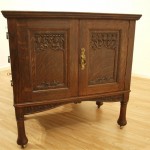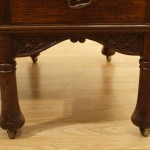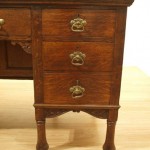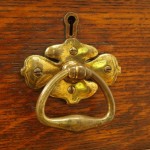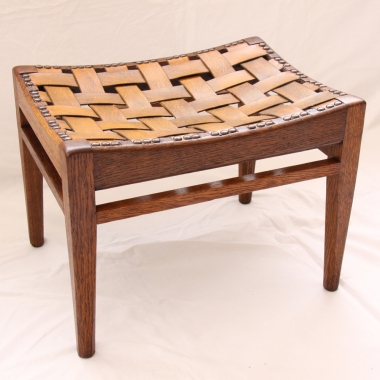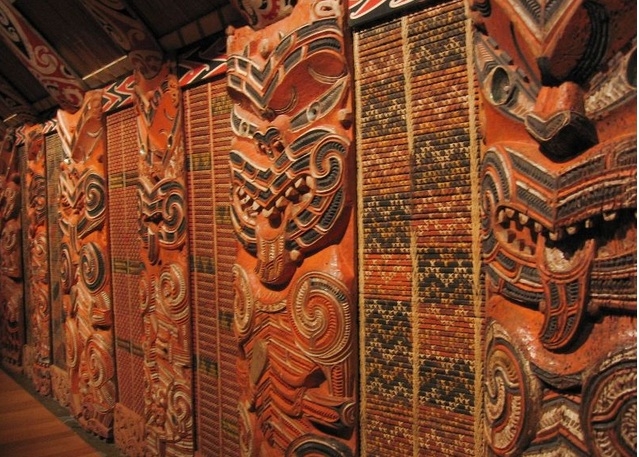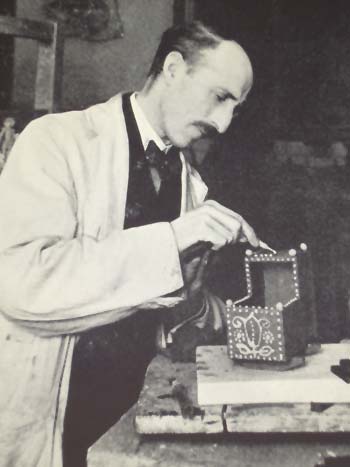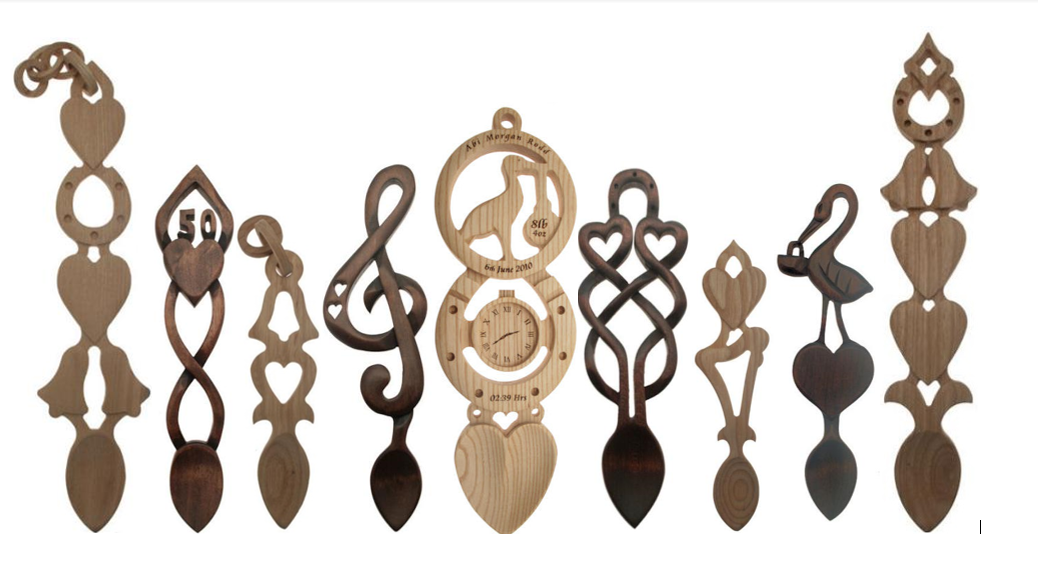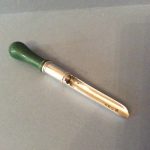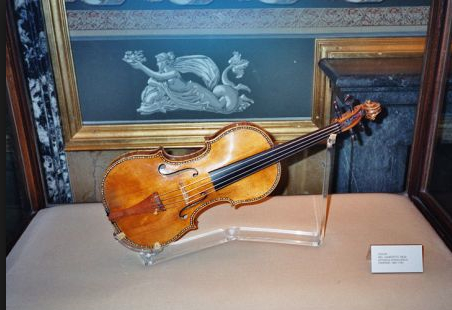Arthur William Simpson (1857-1922), a native of Kendal, served his apprenticeship as a wood carver at Gillow’s of Lancaster. He left in 1879 and spent the following years as a journeyman carver working in Leicester and London before returning to Kendal and setting up a workshop in 1885. He exhibited regularly at The Arts and Crafts Exhibition Society meeting C F A Voysey in 1890’s. His company was successful in producing a wide range of furniture and ecclesiastical carving.
Arthur Simpson is one of the forgotten masters of English Arts & Crafts Furniture. Born in Cumbria, in 1857, he showed an early flair for wood carving, taking two apprenticeships and working in London before returning to Kendal to establish his famous Handicrafts workshop. The clean simple lines and superb workmanship of his Arts & Crafts furniture found a ready market locally. Simpson died in 1922, but the workshop continued under the guidance of his son until 1950. Many of Simpson’s finely crafted antique cabinets, chairs and chests can still be found in Cumbria today.
His apprenticeship commenced at the age of 14, with a Kendal cabinet maker. At the age of 18 he transferred his skills to Gillow’s of Lancaster, where he showed tremendous scope as a woodcarver. Simpson then worked under Samuel Barfield in Leicester, returning to Kendal as an ‘Architectural and General Wood Carver’.
Initially, he didn’t meet with much success. A devout Quaker, Simpson’s early work was mainly ecclesiastical in nature, similar to other neo-Gothic styles of the period. In despair he went to London, finding work with H. Faulkner Armitage of Altrincham, where he quickly discovered what the current trends were.
In 1885, Simpson returned to Kendal, this time concentrating on both the ecclesiastical and domestic market. He was so successful that he was able to move to larger premises and, by 1888, was employing several workers. It was at this time the Handicrafts workshop was established.
From neo-Gothic to Arts & Crafts Furniture
Simpson’s early period lasted until the 1890s, still heavily influenced by his church commissions. His antique chests and cabinets from this period are traditionally designed, and intricately carved with floral motifs. Where signed, they’re carved with his initials AWS.
The breakthrough came in 1889, when a piece was selected for the London Arts and Crafts Society Exhibition. From then until 1914 his style changed dramatically; his antique bookcases, wardrobes, cabinets and chairs adorned with a more formalised, abstract style of carving. To emphasise this new, minimal approach, Simpson used light English oak; oiled, polished and waxed to reveal its natural beauty. He had more than 60 timber suppliers on his books – to him, the beauty and quality of the wood was everything.
In the early 1900s, Simpson struck up an unlikely friendship with the urbane Arts and Crafts designer and architect C.F. A. Voysey, who designed Simpson’s lakeland house in 1908. Simpson was highly influenced by Voysey’s style between 1900 and 1910, his antique bookcases and cabinets now light, spacious and free of ornamentation. His antique dining chairs often feature leather seats and high cut-out backs.
Simpson abandoned Voysey and turned to the Scottish Revivalists for inspiration around 1908. The antique chests and cabinets he produced in Cumbria at the time again featuring intricate carving and fine embellishments. By the time he died in 1922, the demand was for “modern” furniture so his son reinvented traditional pieces. Enduring two world wars and the Great Depression unscathed,
Handicrafts finally shut its doors in 1950 but the beauty and simplicity of Arthur Simpson’s Arts & Crafts furniture lives on in the homes and antique dealerships of Cumbria.
Circa 1922
Genuine A W Simpson rectangular oak and lattice leather topped ‘Easy Stool’. The webbed leather seating is held in place by copper upholstery studs. Four square corner legs, joined by stretchers, each tapering to an octagonal foot. Correct painted brass label to the underside, also inscribed with the job number 7327 and patent registration number 695391. Very popular in the early 20th C, it was the only item Simpson’s patented in an effort to stop other manufacturers inferior copies.
Superb condition, the oak has a lovely aged and waxed patina and all the joints are sound. The leather has been replaced in the past and presents with a lighter colour on exposed parts but is much darker to unexposed surfaces.
Size: 40.5(w) x 30.5(d) x 30.5(h) cm.
For those interested in learning more about his life and work we can highly recommend the following two books:
The Simpsons of Kendal, Craftsmen in Wood 1885 – 1952 by Eleanor Davidson, published 1978.
The Beautiful Furniture of The Simpsons of Kendal by Hugh Wright, published 2011. (Author of Stanley Webb Davies)


